Mexico City: Is Red Bull’s Era Ending or Just Evolving?
This newsletter covers the F1 race in Mexico City and explores how McLaren’s rise and Red Bull’s resurgence are reshaping the fight for the 2025 World Championship, marking a pivotal turning point on the road to Abu Dhabi.
At a Glance
- Setting the Stage
- Cracks in the Crown
- McLaren's Momentum
- The Race Recap
- The State of the Grid
- Looking Ahead: São Paulo
Setting the Stage
High altitude, thin air and an arena of roaring fans unlike anywhere else on the F1 calendar. The Autódromo Hermanos Rodríguez once again proved why it stood as one of Formula 1’s most distinctive battlegrounds. At over 2,200 meters above sea level, the conditions pushed engines to their limits and tested the precision of every driver on the grid.
For years, Red Bull has thrived in Mexico City, and Max Verstappen’s mastery and the team’s aerodynamic efficiency had made this circuit feel like home. But heading into this weekend, the air around their dominance felt uncertain.
McLaren has already clinched the Constructors’ Championship and carried both Lando Norris and Oscar Piastri atop the Drivers’ standings, a testament to their consistency and rapid mid-season development. Red Bull, by contrast, has spent much of the year chasing their old form, relying on Verstappen’s brilliance to keep them in the fight.
By Sunday evening, Mexico City delivered clarity. The race became less about altitude and more about attitude – a reminder that dynasties don’t disappear overnight, and challengers don’t wait their turn.
Want to learn how to analyze data and build amazing data stories? Join Data Punk Media today!
The Rise and Reign of Red Bull
Few eras in Formula 1 history had been as dominant or as meticulously built as Red Bull’s run over the past five seasons. As shown in the graph below, the team’s climb began long before the trophies arrived. Max Verstappen joined Red Bull in 2016, and while his raw speed was obvious from day one, it wasn’t until 2020 that the pieces truly fell into place.
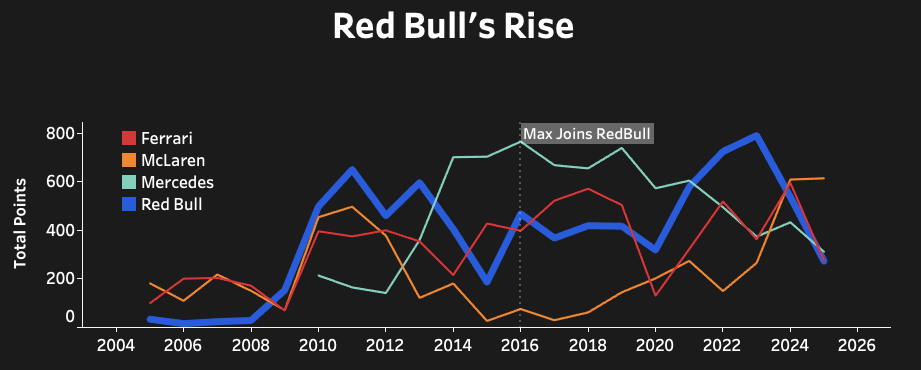
The turning point came in 2021. Verstappen captured his first Drivers’ Championship after a season-long duel with Lewis Hamilton, while Mercedes narrowly claimed the Constructors’ title. The following years, however, belonged entirely to Red Bull.
In 2022, Verstappen and Red Bull crushed the competition, winning both the Drivers’ and Constructors’ Championships by enormous margins. In 2023, they repeated the feat, even more emphatically, with Verstappen finishing hundreds of points ahead of his own teammate. By then, Red Bull’s dominance had become the benchmark for modern performance: aerodynamic mastery, flawless pit strategy, and unmatched consistency.
The streak continued into 2024, though the gap finally began to tighten. Verstappen still secured the Drivers’ crown, but Lando Norris’s relentless pace kept the fight alive deep into the season. McLaren ultimately edged out Red Bull for the Constructors’ title by the slimmest of margins – a symbolic shift after years of Red Bull control.
Be sure to also check out our Instagram site for regular updates and posts on our F1 coverage.
Cracks in the Crown
For years, the Formula One landscape had been defined by Red Bull’s dominance, but the data told a new story. As shown in our graphic comparing Red Bull (blue) and McLaren (orange), the lines that once moved in opposite directions have finally intersected.
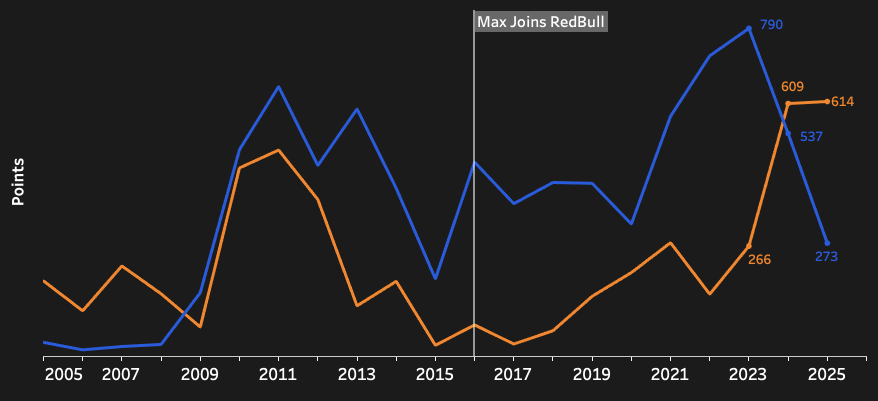
The first real cracks appeared in 2024. While Verstappen still captured the Drivers’ Championship, Red Bull’s grip on the Constructors’ title slipped away. McLaren edged them out by the smallest of margins, but the warning signs had been there all season. Sergio Pérez’s inconsistency became impossible to ignore with frequent qualifying struggles and mid-pack finishes that left Verstappen carrying the team single-handedly. For the first time in years, Red Bull’s dominance depended on one driver rather than a complete machine.
The 2025 campaign only magnified that instability. Red Bull began the year with Liam Lawson in the second seat, but after just two races, he was replaced by Yuki Tsunoda – a move that failed to provide the spark the team needed. Tsunoda’s performances were steady but unspectacular, and once again Verstappen found himself without a teammate capable of matching his pace or delivering consistent points.
While Max’s precision and consistency has kept him mathematically alive in the Drivers’ Championship, Red Bull’s inability to find a second driver who could complement his performance cost them dearly. In a season defined by tight margins, that weakness took them out of the Constructors’ Championship fight entirely as McLaren was able to win it all in Singapore with 6 races remaining.
The result was a rare sight in modern Formula 1 – Red Bull chasing shadows while McLaren turned consistency into control.
McLaren's Momentum
McLaren had found something special – not just in their car, but in their drivers. Lando Norris and Oscar Piastri proved to be one of the most balanced and effective pairings on the grid, combining raw pace with remarkable consistency. Their ability to extract performance week after week has turned McLaren into a powerhouse, and by the end of 2024, it paid off. Despite Max Verstappen’s personal dominance, McLaren’s dual strength delivered them the Constructors’ Championship, a title Red Bull had held for the previous 2 years.
That momentum carried into the first half of the 2025 season. McLaren looked untouchable. Norris and Piastri traded podiums and wins with clockwork precision, and it seemed inevitable that both the Constructors’ and Drivers’ Championships would belong to them.
But Red Bull, and Max, refuse to fade. Somewhere midseason, they seemed to rediscover their rhythm. Verstappen’s consistency turned into momentum, and that momentum turned into results. A series of dominant drives brought him back into contention, cutting deep into the points gap that once looked impossible to close.
That resurgence made Mexico City feel like the perfect storm for Verstappen – a track where both history and form aligned. Our Drive Score chart below, “If Past is Prologue,” reinforced just how dominant both he and Lewis Hamilton had been around the Autódromo Hermanos Rodríguez, sitting atop the all-time leaderboard for performance at this circuit. Hamilton’s record in Mexico remains one of the most consistent in the hybrid era, and with both drivers showing flashes of their old brilliance heading into the weekend, it felt like the stage was set for another classic chapter between two of the sport’s defining talents.
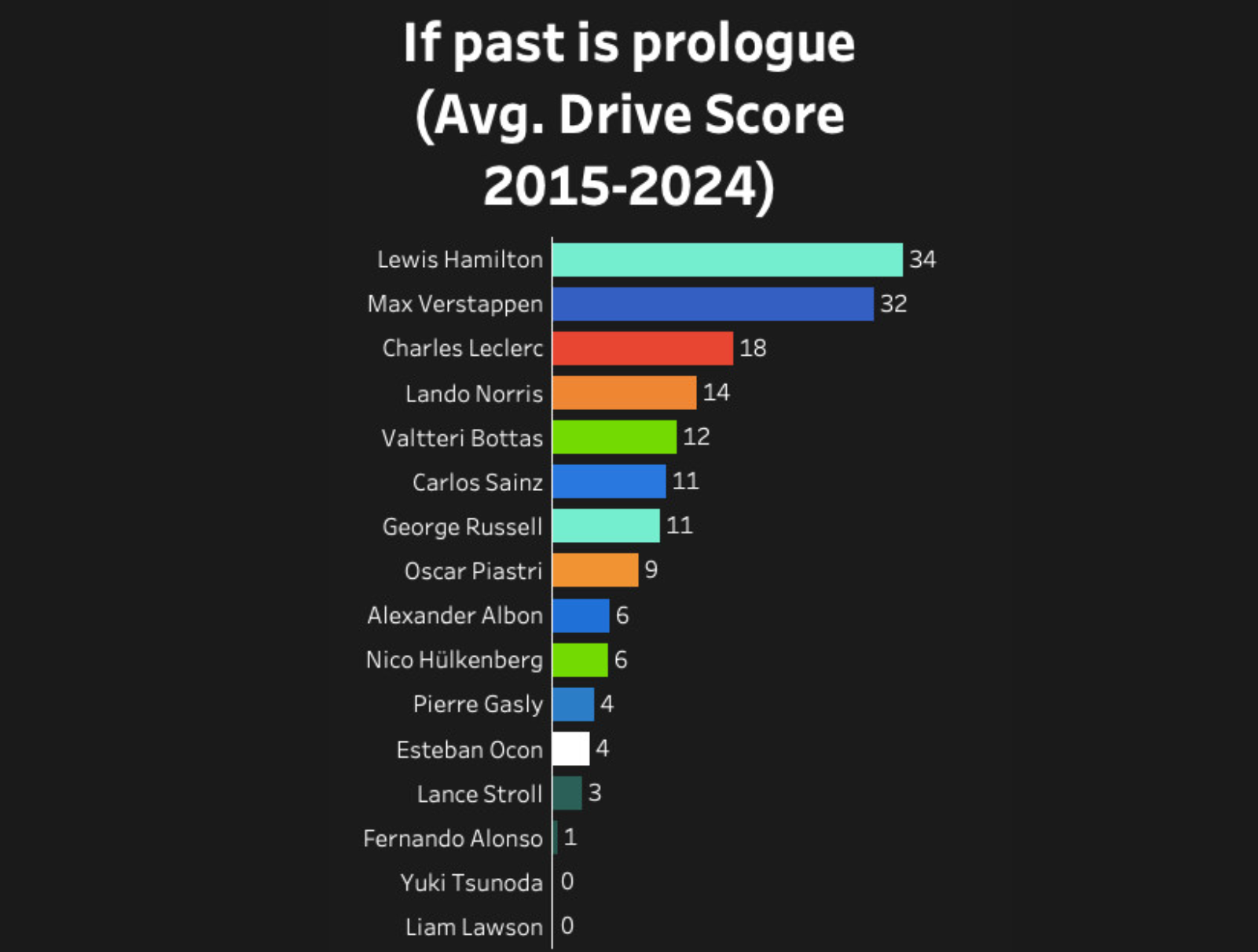
As the paddock arrived in Mexico City, Verstappen remained very much in the hunt. McLaren’s duo of Norris and Piastri still led the standings, but the gap had narrowed with each passing weekend. Verstappen’s recent surge, coupled with his strong track record at the Autódromo Hermanos Rodríguez, made this race feel like a pivotal opportunity to shift the balance. McLaren might have already secured the Constructors’ crown, but the Drivers’ Championship is far from settled. With momentum firmly on his side and a circuit that historically suited him, Verstappen entered Mexico as a man on a mission – one capable of turning the title fight upside down.
The question now was simple: could McLaren hold off Verstappen’s charge and seal both championships, cementing their new era of dominance? Or would Mexico City mark the start of another Red Bull resurgence, proof that their reign wasn’t over, just momentarily paused?
Join Data Punk Media today and explore the different data stories we publish.
The Race Recap
The Mexico City Grand Prix delivered everything it promised – chaos at the start, strategy in the middle, and tension to the very last lap.
Lando Norris lined up on pole ahead of Charles Leclerc and Lewis Hamilton, with Verstappen starting fifth on a different strategy being the only driver in the top seven on medium tyres. What followed was a dramatic opening through a few corners that saw multiple cars forced off track to avoid contact. Verstappen and Leclerc both took to the runoff, while Haas' Ollie Bearman surged from ninth to fourth, seizing his moment amid the commotion.
The early laps were filled with close battles, but the defining moment came on lap 6, when Hamilton and Verstappen went wheel-to-wheel. Hamilton left the track while defending and was later handed a 10-second penalty for gaining an advantage, which he served during his first and only pit stop. The penalty dropped him into the midfield for the remainder of the race, ending any hopes of a podium finish.
Once the field settled, Piastri found himself stuck behind Yuki Tsunoda in a DRS train until lap 11, when the McLaren driver finally broke free. The first pit stops began around lap 26, shuffling the order as most front-runners swapped from softs to mediums, except Verstappen, who flipped his strategy and bolted on softs for the remainder of the race.
The second half of the race turned into a battle of endurance and tyre life. Some drivers, including Bearman, Russell, Piastri, Antonelli, and Hamilton, opted for a second stop onto fresh softs, while Norris, Leclerc, and Verstappen committed to a one-stop run to the flag. Norris maintained control out front, Leclerc held firm in second, and Verstappen began closing the gap with relentless pace on fresher rubber. Behind them, Piastri passed Russell for fifth on lap 60, and Antonelli followed soon after, as Russell's pace began to fade.
But just as Verstappen and Piastri both looked ready to pounce, Verstappen within a second of Leclerc, and Piastri within a second of Bearman, the race took a cruel twist. Carlos Sainz had an incident with his Williams which triggered a Virtual Safety Car on lap 70, freezing the field. The caution ended halfway through the final lap, leaving too little time for any last-lap drama.
Lando Norris crossed the line to claim his first-ever win in Mexico City, finishing in 1:37:58.574 with a massive 32-second cushion over Leclerc in second. Verstappen completed the podium in third, Bearman secured a career-best fourth for Haas, and Piastri rounded out the top five.
For McLaren, it was another statement of dominance. For Verstappen and Red Bull, another reminder that while the Constructors’ battle was lost, the Drivers’ Championship is far from finished.
The State of the Grid
Drivers' Championship
With four races remaining, the 2025 Drivers’ Championship has become a three-way showdown, with one longshot still mathematically in the mix. Lando Norris’s victory in Mexico City earned him 25 points and returned him to the top of the standings for the first time in 189 days, reclaiming the lead he lost to his McLaren teammate Oscar Piastri after the Saudi Arabian Grand Prix earlier this season. Norris now leads with 357 points, just one ahead of Piastri's 356.
Max Verstappen’s third-place finish brought him to 321 points, continuing his steady climb and tightening the gap to the McLaren pair. His recent momentum, paired with strong performances at Red Bull’s most successful circuits, has kept the title fight alive deep into the season. George Russell remains mathematically eligible with 258 points, though it would take a perfect run and major missteps from the front three for him to close the gap. While the data says four drivers remain in contention, the fight for the crown is realistically between Norris, Piastri, and Verstappen.
The accompanying line graph captures the picture perfectly showcasing McLaren’s dominance up front, Verstappen’s resurgence through late-season consistency, and Russell hanging on at the outer edge of possibility.
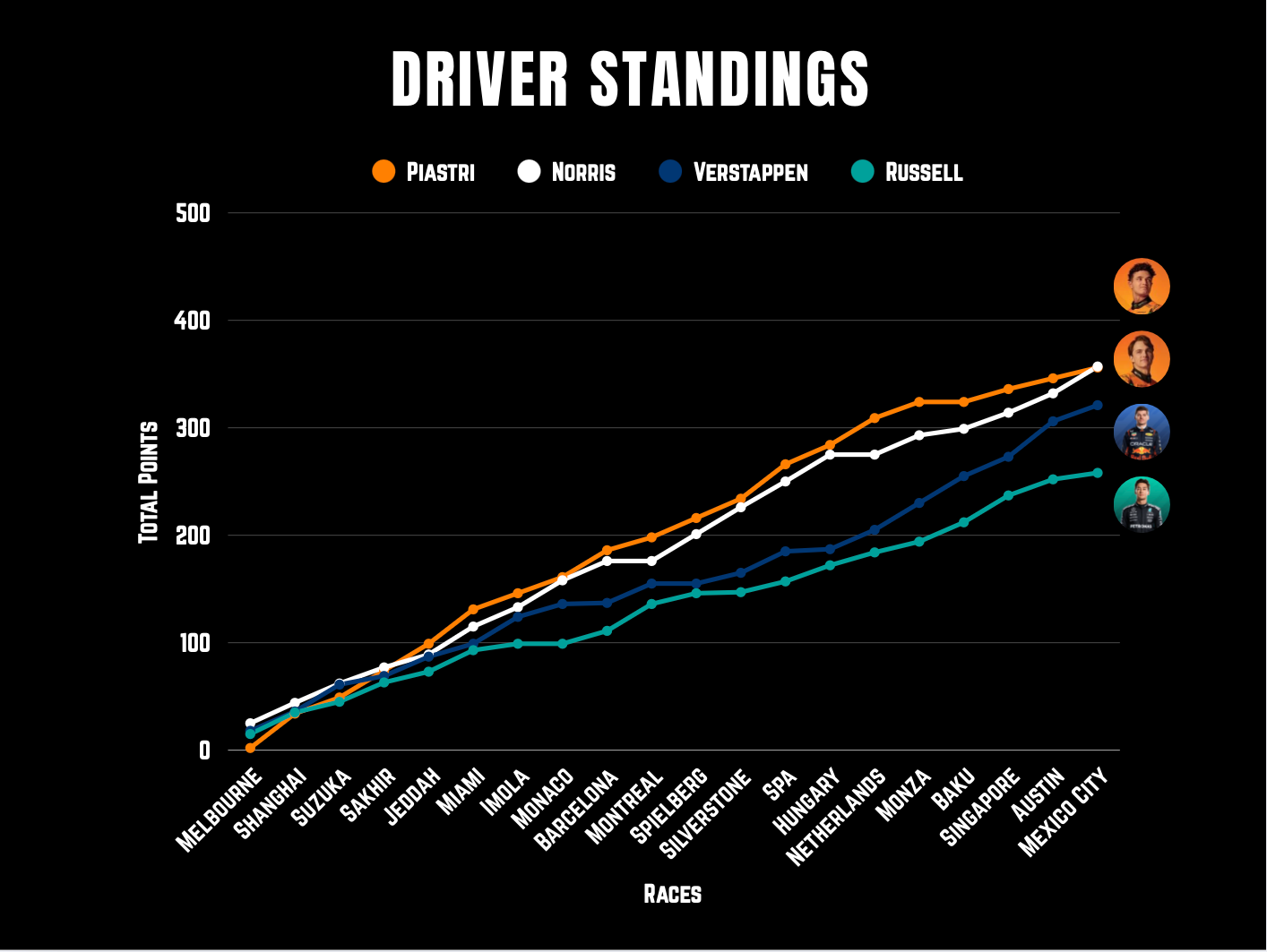
Constructors' Championship
While McLaren has already wrapped up the 2025 Constructors’ Championship weeks ago, the fight for second place has become one of the most compelling storylines left on the grid. After Charles Leclerc’s runner-up finish in Mexico City, Ferrari edged ahead of Mercedes by a single point – 356 to 355 – with Red Bull still firmly in the mix at 346.
Just ten points separate the three teams, setting up a battle nearly as tight as the Drivers’ Championship itself. With four races remaining and each team showing flashes of pace in different conditions, the race for second could come down to consistency, strategy, and which car finds performance when it matters most.
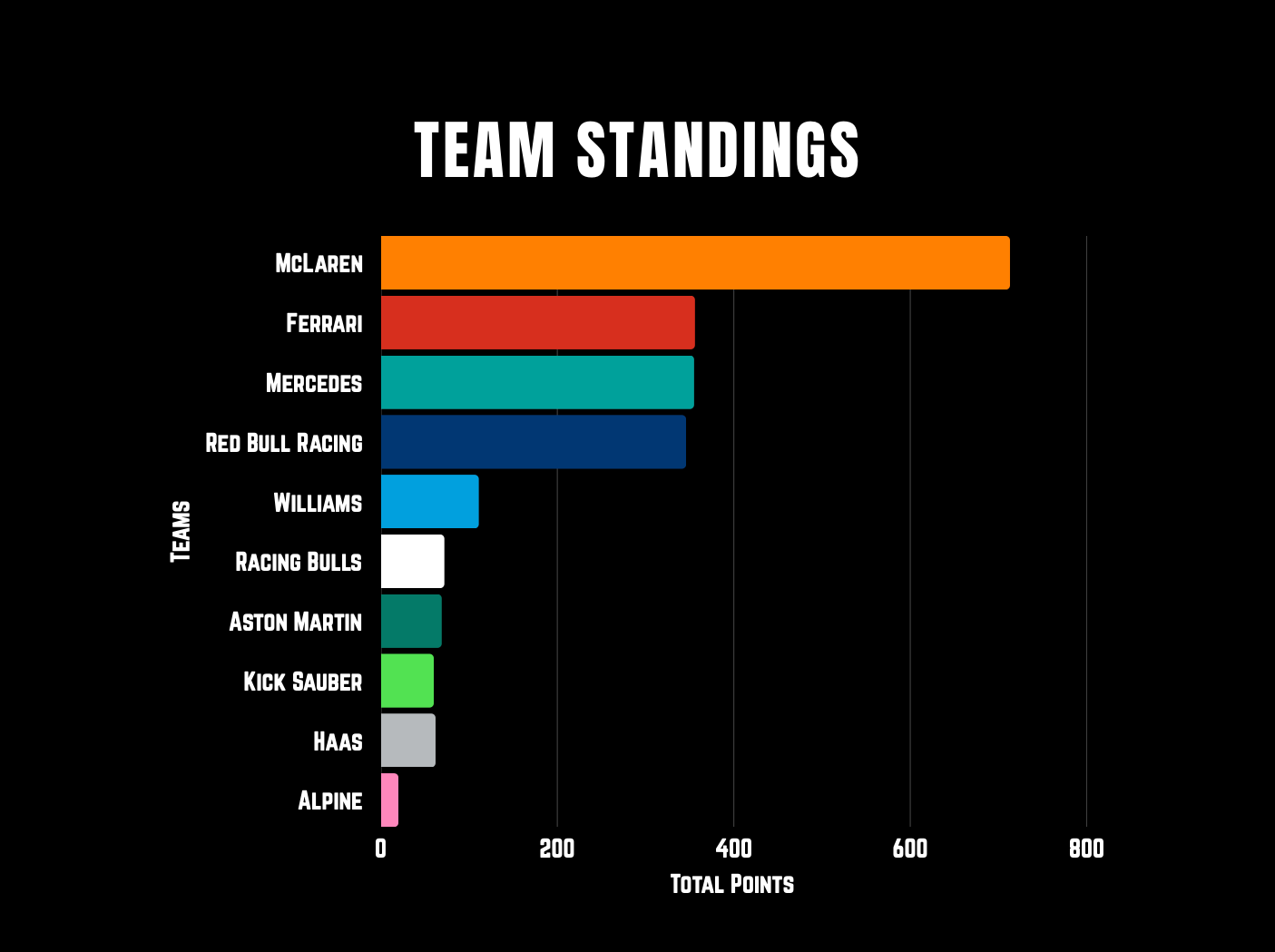
Looking Ahead: São Paulo
Next, the Road to Abu Dhabi heads to São Paulo – home of the Autódromo José Carlos Pace, better known as Interlagos. A track that has built its reputation on unpredictability, Interlagos has produced some of the most chaotic and unforgettable moments in Formula 1 history.
From sudden downpours to dramatic last-lap twists, no race ever unfolds the same way in Brazil. This time, with the championship picture tightening and emotions running high, every corner could carry consequences.
Our next story will take a data-driven look at why Brazil so often descends into chaos, tracking DNFs, position changes, and shock results to uncover whether Interlagos truly lives up to its reputation as F1’s most unpredictable battleground.

